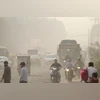Indian cities achieved an average 27 per cent reduction in PM2.5 pollution levels from 2019 to 2024, with those under NCAP alone recording a 24 per cent decline, a new report has found.
According to the report by climate tech firm Respirer Living Sciences, Varanasi and Moradabad reduced PM2.5 levels by 76 per cent and 58 per cent, respectively.
Other top performers include Kalaburagi (57.2 per cent), Meerut (57.1 per cent), Katni (56.3 per cent), Agra (54.1 per cent), Baghpat (53.3 per cent), Kanpur (51.2 per cent) and Jodhpur (50.5 per cent).
"Air quality has improved considerably, with a 27 per cent decline in PM2.5 levels across all monitored cities since 2019. NCAP (National Clean Air Programme) cities alone achieved a 24 per cent reduction, showing progress in combating air pollution," according to the report.
Despite the improvements, several cities remain highly polluted.
Also Read
In 2024, Delhi recorded PM2.5 levels of 107 microgrammes per cubic metre while Byrnihat in Assam reported 127.3 microgrammes per cubic metre.
Other highly polluted cities include Gurugram (96.7 microgrammes per cubic metre), Faridabad (87.1 microgrammes per cubic metre), Sri Ganganagar (85.5 microgrammes per cubic metre), and Greater Noida (83.9 microgrammes per cubic metre).
The list of the most polluted cities also includes Muzaffarnagar (83.2 microgrammes per cubic metre), Durgapur (82.0 microgrammes per cubic metre), Asansol (80.3 microgrammes per cubic metre), and Ghaziabad (79.9 microgrammes per cubic metre).
"India's air quality is a story of both hope and caution," said Ronak Sutaria, founder of Respirer Living Sciences. "While cities like Varanasi have achieved remarkable progress with a 76.4 per cent reduction, northern regions, including Delhi-NCR, Rajasthan, Haryana, Punjab, and Uttar Pradesh, continue to face severe pollution episodes." India launched NCAP in 2019, aiming to reduce particulate pollution by 20-30 per cent by 2024, using 2017 as the base year. The target was later revised to a 40 per cent reduction by 2026, with 2019-20 as the base year.
In practice, only PM10 concentration is being considered for performance assessment.

)